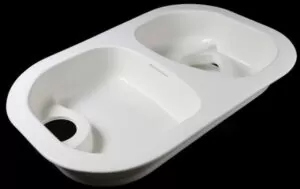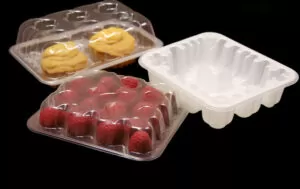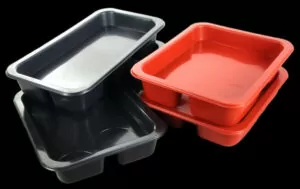PP (polypropylene resin) thermoforming sheet is currently the most widely used plastics and used type of sheet in positive pressure thermoforming. Even among the entire family of thermoforming sheets, PP has long since caught up with it due to its good heat resistance and low electrical conductivity, and its usage is almost the same as that of PVC and PS materials.
At present, the “disposable” plastic jelly cups, sanitary drinking cups, soy milk cups, tofu boxes, etc. that can be seen everywhere on the market are almost 100% made of PP plastic sheets by vacuum forming. In the “disposable” plastic yogurt cup market, PP plastic sheet also occupy most of the market. There are so many “disposable” fast food boxes, instant noodle bowls, cold drink cups and other products in daily life that are thermoformed from PP plastic sheets that are countless.

Plastic packaging products thermoformed from PP plastic sheets are widely used in medicine, light industry, disposable cups, medical equipment, non food packaging, toys, food packaging, tourism and other fields. The main reason is that PP plastic sheet is one of the lightest plastic varieties, with a density of only 0.89-0.91g/cm³, and the material cost is low. Secondly, the price of raw materials is relatively cheap, and the market supply is sufficient and easy to purchase. In addition, compared with injection molding, thermoforming production technology is easier to master, the ingredients are simple, and it is easy to process. The most important thing is that the production equipment is cheap and easy to start up.
Here are some types of thermoforming plastic designs you should know about:
Thin-Gauge Thermoforming, Thick-Gauge Thermoforming, Plug Assist Forming, Pressure Forming, Two Plastic Sheets Forming
With the innovation of plastic sheet production lines, the introduction of foreign investment and imported equipment, and the application of new raw and auxiliary materials, the pressure forming industry is booming. Thermoforming plastic sheet processing technologies also vary with equipment, materials and applications.
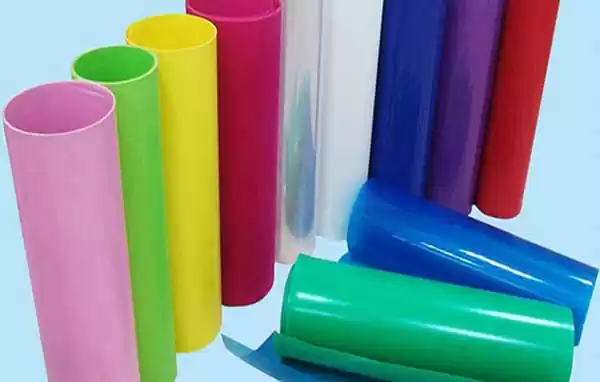
The increasingly mature plastic sheet processing technology gradually breaks the old conventional theory. Now, even in the same plastic sheet production line, different processes can be used to produce qualified sheets for different uses, specifications, and materials. Sheets of the same specification and use can also be processed using different equipment and processes. “Modeless” brings great convenience to production.
PP thermoformed plastic sheets can be produced by calendering, calendering, and drooling (with or without air knife). In this article, we will talk about some technologies for producing various PP thermoformed sheets using the “calendering method”. This is for your reference only, please criticize and correct any inaccuracies.
This article takes the simplest equipment configuration of “extruder-T-shaped die-vertical three-roll calender-traction-coiling” as the benchmark. (High-end plastic sheet production lines generally use “precision extrusion” technology, with PLC highly automated programmable computer control systems, melt pumps, static mixers, etc. Most of the three rollers are horizontal structures, independently driven by servo motors, and equipped with Independent circulating water control system is generally produced using the “calendering method”.

Generally, in order to prevent the deformation of rollers and frames from affecting the sheet processing accuracy, in principle it is not recommended to use the “calendering method” in high-end thermoplastic sheet production lines. Therefore, some high-end plastic sheet production lines have automatic protection functions. When producing sheets by calendering, if the three-roller drive motor is overloaded, the entire production line will automatically stop. )
The biggest difference between the “calendering method” and several other methods is that there is an obviously smooth and uniform residual glue rotating between the first and second rollers where the machine head enters. The third roller generally does not need to be pressed. The middle roller. Since there is a certain amount of residual glue between the rollers, which plays a big role in stable production, ordinary electromechanical configuration is sufficient. That is, there is no need for melt pumps, static mixers, PLC highly automated programmable computer control systems, etc. Can greatly reduce investment costs and production costs. It’s just that the strength of the roller and frame is higher than that of the “calendering method” and “salivation method” because the rollers are subject to greater separation force. When produced by the “calendering method”, the operation is easy, workers can easily master the technical essentials, and equipment maintenance is also very simple.
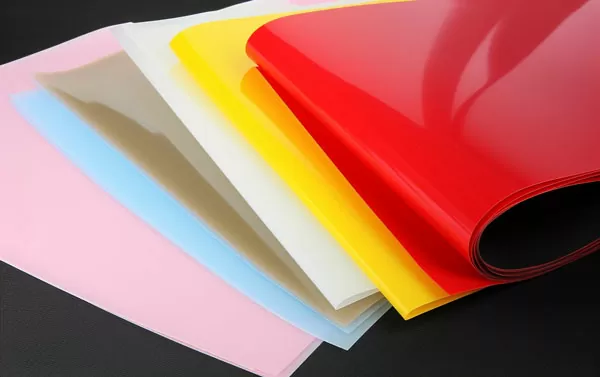
Common selection of PP raw materials for thermoforming: PP pellets are usually extruded plate grade, plastic sheet grade, drawing grade, narrow strip grade or vacuum forming grade.
Thick Sheets
When using the “calendering method” to process thicker PP “positive pressure thermoforming plastic sheets (0.50-2.50 mm), the PP plastic sheet is highly adaptable to the equipment and the process requirements are relatively loose.
Take vertical three-roller feeding as an example: when produced using the “calendering method”, there is excess glue between the upper roller and the middle roller, which is as thin as a pencil. When producing 0.50mm-2.5mm or even thicker positive pressure thermoformed PP plastic sheets, the equipment has a wide adaptability range and process adjustment is relatively easy. In addition, there are several advantages:
Strong Adaptability to Screws and Material Barrels
When using the “calendering method” process to produce PP positive pressure thermoforming plastic sheets, the PP sheet has strong adaptability to the screw and material barrels.
Whether it is the theoretically recommended single screw of special, sudden change, separation type, L/D=22-25, or gradual change, universal, exhaust type, L/D=2O-35, barrier type, split flow type, etc. Other new single screws have been successfully produced in actual production.

This is because in actual production, each factory has different strengths and cannot all have dedicated equipment or configurations. In addition, materials are frequently replaced, and it is impossible to replace them with dedicated barrels and screws every time. Therefore, in actual production: a sheet production line can be used to produce HIPS, CPS, ABS plastic sheets, and can also be arranged to produce PP sheet and PE sheets. It can also process PP degradable materials and PP and PE sheets containing filled masterbatch. material. Enterprises specializing in the production of sheet production line equipment, the plastic sheet production lines launched are generally suitable for processing PP materials.
The Operating Process is Highly Adaptable
When using the “calendering method” process to produce PP positive pressure thermoforming plastic sheets, the PP material affects the machine head structure, speed regulation mode, transmission mode, temperature control mode, lip opening, and feeding mode (upper feeding, lower feeding ) is highly adaptable.
The processing range of PP materials is wider, so the temperature settings are also wider. Since the melting point of PP sheet is 164-170°C, in actual production, the processing temperature can be set from 170°C to 270°C, which varies depending on the place of production of the material, the equipment, and the place of processing.

There are generally no strict requirements for the lip opening, but the lip opening should be at least greater than the thickness of the sheet. In actual operation, there are many sheet specifications, and it is troublesome to adjust the lip opening. You can even always use the lip that produces the thickest sheet. Some use lip (thickness) opening ≈ sheet thickness x (1+10-30%). In some cases, when the sheet thickness is less than 0.8mm, the lip opening is 1.0mm. When the plastic sheet thickness is greater than 0.8mm and less than 1.5mm, the lip opening is 2.0mm (because the thickness of the general pressure forming sheet is very small more than 2.0 mm).
The more common temperature of the circulating water in the three rollers is controlled at 30℃-80℃. The three-roller circulating water circuit has several modes such as series connection, parallel connection, and independent control, all of which can meet production requirements.

Thin Sheets
When the “calendering method” is used to process thinner PP “positive pressure thermoforming sheets” (0.30-0.40 mm), the adaptability of the PP material to the equipment is relatively weakened, and the process requirements are also more stringent.
Production Process
Take a certain plastic sheet production line as an example: when using the “calendering method” to produce 0.36mmX620 CPP, the normal production process records are as follows:
Ingredients: T30S powder (Puyang) 25Kg, transparent crushed material 105Kg (including 90Kg thick crushed material), transparent agent 0.03Kg. Body temperature: 190-225-240-240-245-245 (unit: ℃) . Machine head temperature: 225-222-225 (unit: ℃) (4) Host (meter display): 1500 r/min, three rollers (table display): 725 r/min. Temperature of the three rollers (the temperature of the outlet nozzle measured with a thermometer): upper roller 47°C, middle roller 47°C, lower roller 35°C. Remaining glue status: thick as a pencil, evenly distributed, well rotated (7) Lip Opening: 1.20mm. Distance between machine head and middle roller: 170mm. Filter: 60 mesh*3 + 80 mesh*2. Sheet quality: The surface is good, the tensile properties are good (tested on a pressure thermoforming machine), the plastic cup is not damaged, the bottom is not whitish, and the transparency is good.

Notice
(1) The body temperature can also be reduced by 10-20℃.
(2) This formula is used when there is a lot of recycled material and the color requirements of thermoformed products are not too high.
(3) Through the test, when the temperature of the upper and middle rollers is lower than 45°C, the main machine is at 1300r/min, the remaining glue remains unchanged, and the surface quality of the thermoformed sheet is good. However, when testing the formability of the “Little Plum Blossom Cup” on a positive pressure thermoforming machine, it was found that the tensile properties of the plastic sheet deteriorated, the tensile cracking of the plastic cup increased, and there were many scraps, making normal production impossible. Even if the parameters of the positive pressure thermoforming machine are changed, there is no improvement. Even if the lip opening of the machine head is reduced to 0.60 mm, it has no effect. Therefore, it is determined that the vacuum forming performance of thin polypropylene sheet “positive pressure thermoforming sheets” (0.30-0.40 mm) produced by calendering has a great relationship with the speed of the host machine.

(4) When the main machine speed is 1500 r/min and the roller temperature drops below 35°C, the thermoforming performance of the sheet will also deteriorate and the plastic cup will be difficult to form. However, when the roller temperature rises to 75°C, the thermoforming performance of the sheet is good, but the transparency of the plastic cup becomes poor and the surface is blurred. Therefore, it is determined that the thermoforming performance of thin PP “positive pressure thermoforming sheets” (0.30-0.40 mm) produced by calendering and the transparency of thermoformed products are closely related to the temperature of the three rollers.

Negative Pressure (Vacuum Forming) PP Thermoforming Sheet
If the “calendering method” is used to produce PP thermoforming sheets for negative pressure (vacuum forming), an appropriate amount of PE can be added to the ingredients of the positive pressure thermoforming plastic sheets, or a PE-modified PP extrusion grade can be directly used. Material – copolymer PP. It is common to add extrusion-grade HDPE or LLDPE, LDPE in an amount of 10-50%, or directly use PE-modified copolymer PP extrusion grade to improve the tensile properties of the sheet and increase the yield.
Case
A factory produces PP porcelain white plastic sheet for thermoforming 0.40 mm X700 mm.
The materials are as follows: PP (F401, Yangzi Petrochemical) 100 Kg, PE (5000S, Beiyan) 100 Kg, white thermoforming plastic sheet scraps 80 Kg, degradable masterbatch 100 Kg, porcelain white masterbatch (Shandong) 5 Kg. Equipment used: ф90 Upper feeding, parallel circulating water circuit.

Process parameters:
Body temperature: 225——237——245——248——255——260 (Unit: ℃) Machine head temperature: 240——232——240 (Unit: ℃) Three-roller temperature (hand mold): Upper The middle roller is about 50-60 (unit: ℃) filter: 80 mesh + 120 mesh*2 + 150 mesh*2. Lip opening: 1.5 mm. Residual glue: thick as a pencil, evenly distributed, well rotated. Sheet quality: good surface, (tested on a thermoforming machine) good vacuum forming performance, no cracks or uneven stretching.
illustrate:
The formula of PP thermoforming plastic sheet for thermoforming varies depending on the ease of processing, use, and quality requirements of the product. PP plastic sheets for thermoforming can also be produced by the “salivation method”, which will be described in detail in another chapter. When using the “calendering method” to produce thin plastic sheets, in order to prevent hard debris (gravel, metal) from damaging the machine head, melt pump, and rollers, attention must be paid to placing the magnetic frame and changing the screen in time. Generally, the filters used for producing thin sheets are denser and stronger than those used for thick sheets. Generally, a dedicated network stack is used.

Conclusion
From the above real test records from the production line, it can be seen that the “calendering method” can be used to produce PP thermoforming sheets of various formulas on a variety of equipment with different configurations. Although the “calendering method” is used to produce thin PP thermoforming sheets, there are strict requirements on process parameters such as formula, roller temperature, speed, etc., but after figuring out the rules, it is still easy to operate.
The key to the “calendering method” is to control the remaining glue so that it is always in a bubble-free, stable, uniform and smooth state. There is a certain proportional relationship between the temperature of the roller and the speed of the extruder, and they have a great influence on the thermoforming performance of the thermoformed sheet.



